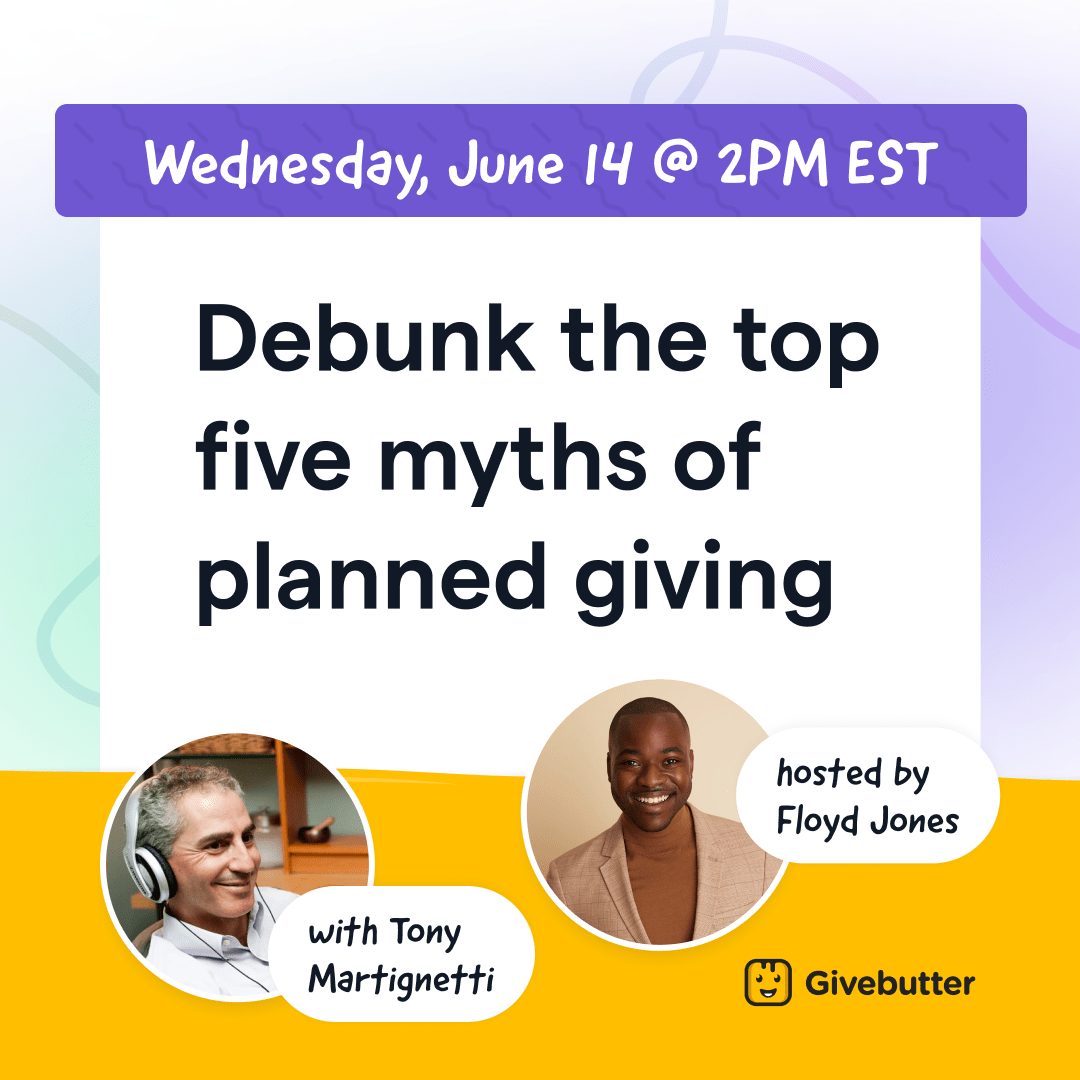Table of contents
Table of contents
Once believed to be a vehicle for charitable giving only for the wealthy, donor-advised funds (DAFs) are rapidly growing in popularity. According to National Philanthropic Trust, DAF giving has increased 400% over the last decade, with most of this growth happening in the past couple of years. DAF grants totaled $45.74B in 2021—up 28.2% from the year before—and there are now close to 1.3 million individual DAF accounts in existence.
Nonprofits of all sizes should take note. 👀
Even though DAFs have been around for decades, new tools are enabling organizations and donors to tap into this investment-based method of giving like never before. In this guide, we’ll cover key things your nonprofit should know regarding DAFs, including:
- What is a donor-advised fund?
- How do donor-advised funds work?
- Donor-advised fund pros and cons
- The easiest way for nonprofits to accept DAF donations
What is a donor-advised fund?
<span id="what"></span>A donor-advised fund is essentially a tax-incentivized investment account for charitable giving. Donors contribute funds to the account, those funds get invested, and money generated from the account is, in turn, given to designated nonprofit recipients.
The finance world is often full of hard-to-understand jargon, so let’s break it down a bit further.
According to the IRS definition, a DAF is “a separately identified fund or account…maintained and operated by a section 501(c)(3) organization…called a sponsoring organization.” These tax-exempt, nonprofit “sponsors” tend to be large institutions with a national reach: hospitals, community foundations, or the charitable arms of for-profit financial corporations like Schwab.
Donors are the individuals, families, or groups (a workplace giving program, for example) that create DAF accounts, make tax-deductible contributions, and advise the sponsoring organization on how money is invested and given out via grants (donations) to charitable organizations from there.
Each DAF sponsor has its own requirements and stipulations, which will suit different donors based on their wealth, geography, and values. Some of the most popular DAF providers include Fidelity Charitable, National Philanthropic Trust, Goldman Sachs Philanthropy Fund, Schwab Charitable, Vanguard Charitable, and the Silicon Valley Community Foundation.
Donor-advised fund vs. private foundation
While both DAFs and private foundations are engines for philanthropic giving and tax deductions, there are some key differences between the two.
You can think of private foundations as large institutions and DAFs as individual accounts. Both entities issue grants to fund important causes, but between letters of inquiry, applications, and meetings, foundations require nonprofits to jump through more hoops to even apply for funding. If and when they do receive a foundation grant, nonprofits can face cumbersome reporting requirements and other obligations (including fees). Even then, grants aren’t guaranteed to be reissued year after year.
There’s a much less formal process (and red tape) involved with DAF grants, which are more accessible to both donors and nonprofits. Anyone in a position to donate money to an organization can create a DAF and arrange for grants to be made to a nonprofit of their choosing—at no obligation to the organization.
Likewise, for major donors considering ways to give, starting a private foundation is a much bigger project than planned giving through a DAF (we’ll cover more pros and cons of DAFs later on!).
DAF rules: How do donor-advised funds work?
<span id="how"></span>So, how can a nonprofit like yours become the recipient of a DAF grant? Here’s how it all comes together, along with some key rules to know about:
Step 1: Contribute 🪙
Donors decide how frequently they want to contribute their cash, stocks, real estate, or cryptocurrency to their DAF. Because the sponsoring organization is technically a charity, they can write large donations off as a tax deduction immediately.
Certain sponsors require a high minimum contribution (Stanford University’s minimum is $1M), and the National Philanthropic Trust reports the average DAF account to be around $182.8K. But times are changing!
New workplace giving DAFs and sponsoring organizations with low or no contribution minimums have attracted new donors at a large scale.
Many DAFs are now accessible to donors at every level. Plus, there are more and more resources available to help demystify the process and give donors the information and tools they need to create their own.
Step 2: Invest 🏦
As with other kinds of investments—like a 401K—DAF donors can choose what level of volatility they are comfortable with and what kind of portfolio they prefer for their investments (stocks, bonds, etc.) over time.
A key difference between a DAF and other investment accounts is that contributions are irrevocable (i.e., they can’t get them back). The sponsoring organization legally controls the funds from there, but donors can weigh in on where the funds go.
Step 3: Give 🎉
Donors have input on when and what kinds of nonprofits will receive grants from their investments—and how much to give. At some sponsoring organizations, like a large university or certain community foundations, the idea is generally that a substantial amount of the grants will go to programs and groups affiliated with the sponsor.
But at a financial institution like Fidelity, donors can have more flexibility. This is where donor outreach and education is crucial. Letting your donors know that you can receive DAF donations will make it more likely that they not only consider creating a DAF account (if they haven’t already) but that they recommend your organization as a recipient for a donation.
Donor-advised fund pros and cons
<span id="proscons"></span>Nonprofits interested in engaging with DAFs should consider the strengths and weaknesses of this giving method—for their organizational needs, the preferences of their donors, and the impact on the wider landscape of nonprofit fundraising.
Benefits of DAFs for nonprofits
- Fee free 💸 At least for grant recipients. Nonprofit Trust breaks it down for us: “Grants from DAFs do not include any grant-related expenditures, administrative fees or operational overhead costs,” which often come with private foundation grants. (Donors do pay fees to DAF sponsors. Fidelity, for example, charges 0.60% or $100 annually.)
- Growth potential 🌱 Investing DAF funds can increase their value, potentially enabling donors to give a higher amount to a charity than they would have been able to otherwise.
- Tax benefits 💰 Donor-advised fund tax benefits are one of the top benefits for contributors—especially for high-dollar donors. Nonprofits may enjoy higher average donation amounts and attract more major donors through a DAF fundraising strategy.
- Administrative support 📊 Sponsor organizations manage all the investing and granting for donors, which can facilitate more consistent planned giving, as well as legacy giving into the future.
DAF downsides
- Less transparency 👤 With DAFs, nonprofits don’t always have access to specific donor information, which can make donor stewardship and building relationships with donors difficult.
- No payout requirements 🤯 The IRS doesn’t require DAFs to make any annual donations. Individual sponsoring charities may require donations to be made each year, but most DAF funds may not reach smaller nonprofit recipients for a long time. But thanks to the efforts of philanthropic groups, policymakers, and researchers to increase DAF payouts, we’ll hopefully be seeing a greater number of donations traveling more quickly to nonprofits in the future.
- Lengthy donation process ⏳ Up until recently, donating through a DAF was typically a complicated process that required donors to leave a nonprofit’s website to recommend them for a donation. Thankfully, that's all about to change...
A revolutionary way for nonprofits to accept DAF donations
<span id="acceptdaf"></span>Givebutter is proud to announce the launch of a first-of-its kind DAF donate button for fundraising campaigns and events! 🤩 Nonprofits can now empower donors to give through their donor-advised fund on any Givebutter donation flow in just a few clicks.
Every single Givebutter campaign page, donation form, fundraising event, and website widget will be able to offer DAF alongside other popular payment methods such as Apple Pay, credit/debit card, Venmo, check—you name it! Thanks to our native integration with Chariot, donors will be able to contribute directly to nonprofits from popular DAF providers, including Fidelity Charitable, Schwab Charitable, National Philanthropic Trust, Charityvest, and more.
We’re making it easier than ever for DAF donors to quickly and seamlessly recommend nonprofits for a donation, enabling them to make a greater and more immediate impact on the causes they believe in. Not only will nonprofits be able to attract and engage a new set of donors, but they’ll also enjoy access to more donor information in their Givebutter dashboard than other DAF donation methods provide.
We’re so excited to bring out the best of what donor-advised funds have to offer by integrating a DAF payment option into our free, all-in-one fundraising platform.
Sign up for your free Givebutter account and start accepting DAF donations today! 💪





.png)




%20(1).png)






.png)






.svg)
.svg)
